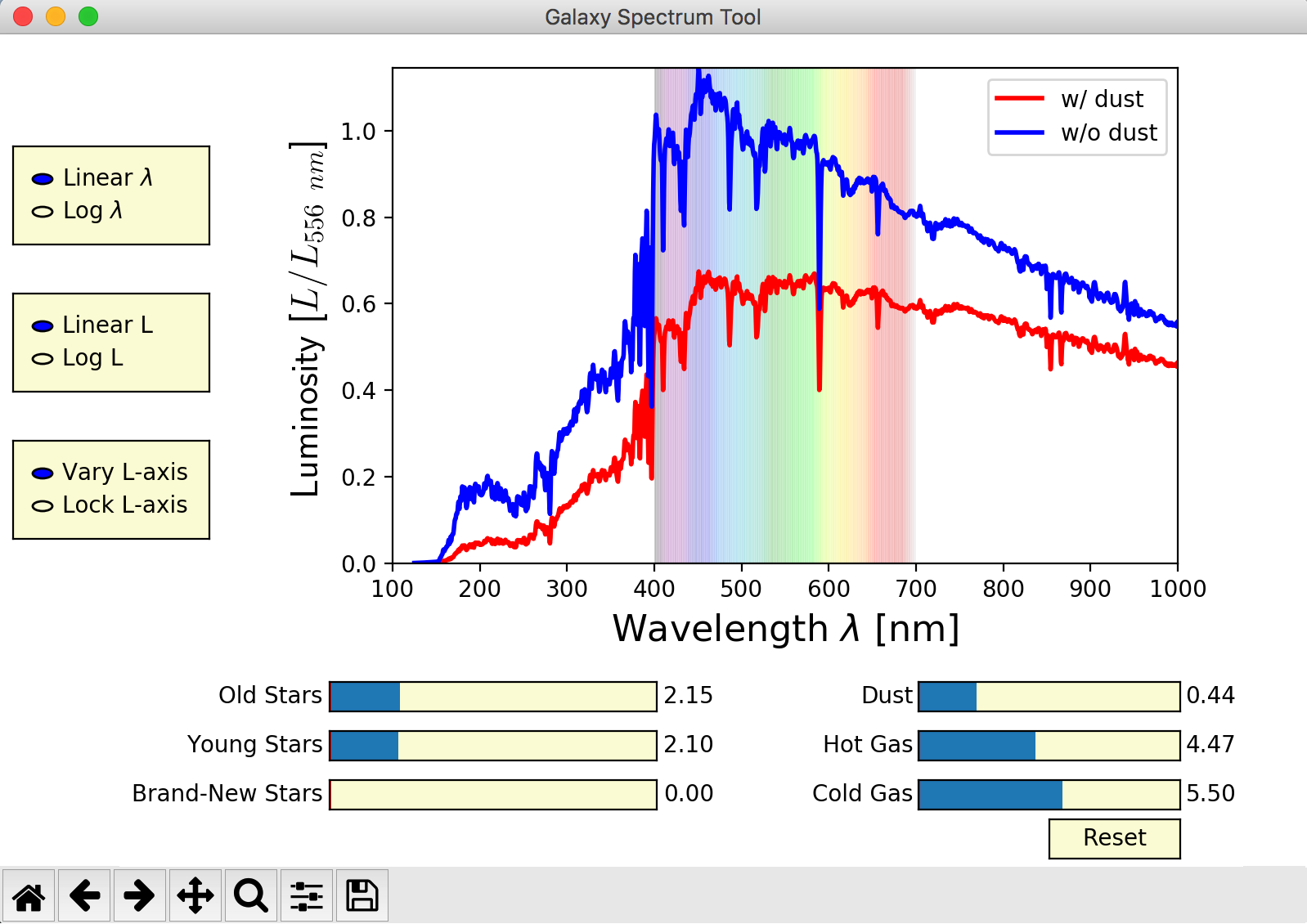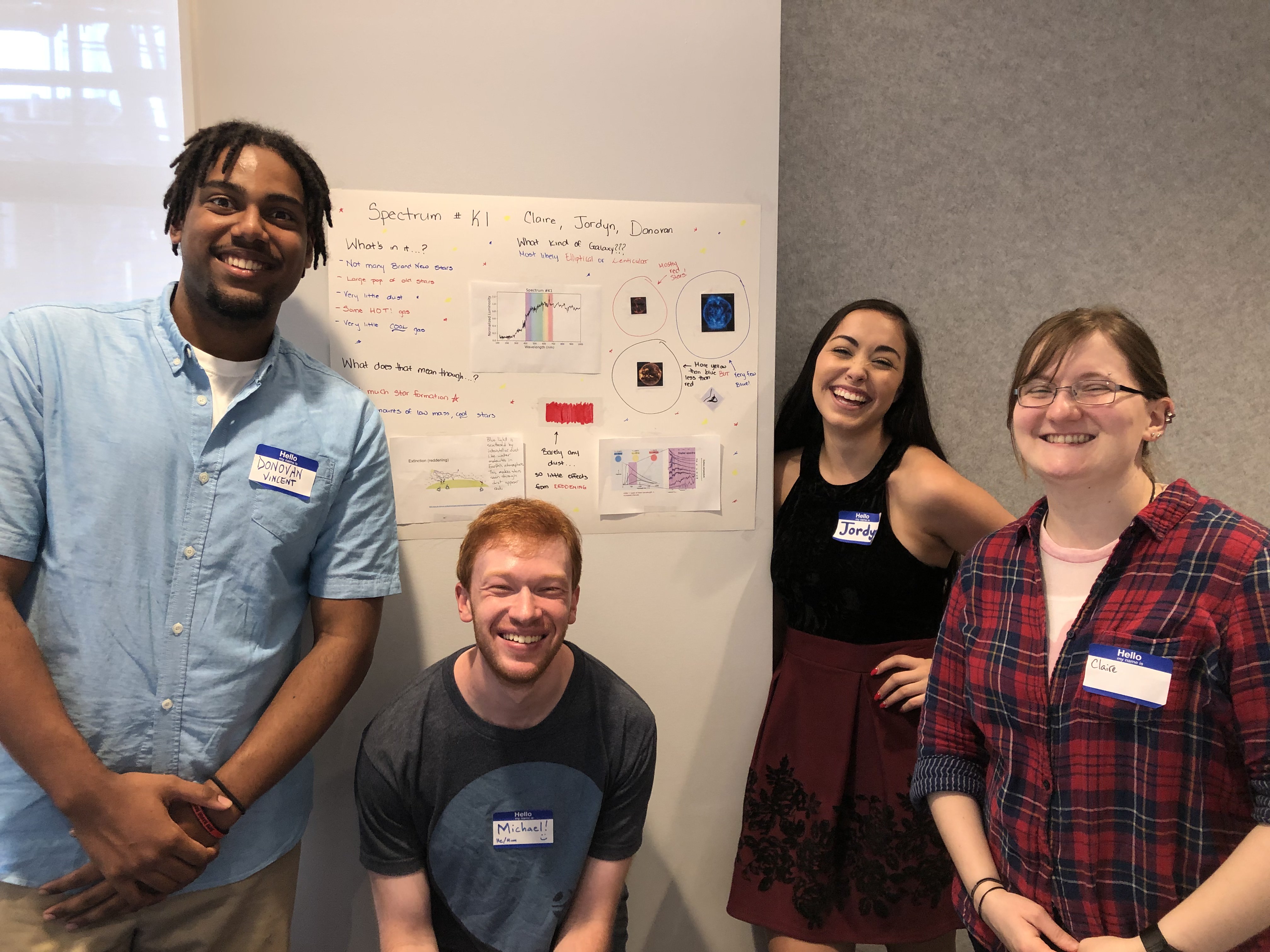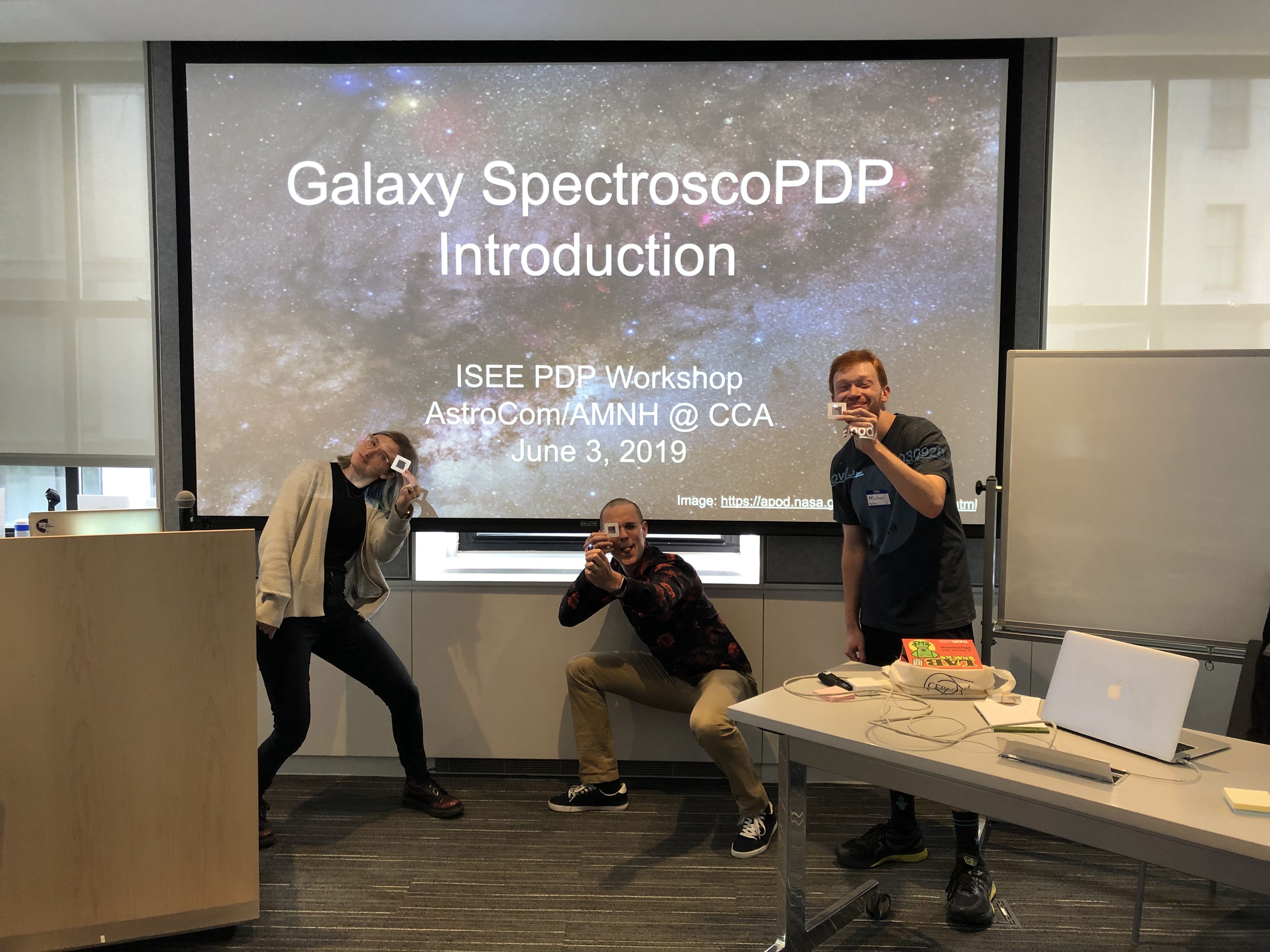
Galaxy spectrum tool
Based on a more technical version by Aaron Robotham.
Outreach Table of Contents
Imagine you are an undergraduate who has never read a research paper. (We were all there at some point.) Wouldn't it be great to have a website that posts daily summaries of recent research papers to help you learn how to read research papers? That is our primary goal at Astrobites: to make reading papers less intimidating. In particular, we focus on reaching out to undergraduates interested in conducting research who have little to no experience reading papers.
When I was an undergraduate, I read Astrobites regularly starting from my freshman year. At first, I found reading papers to be very difficult and didn't know what I could get out of reading the corresponding Astrobite articles either. Over time, however, I began to learn more from reading Astrobites. Eventually, reading papers became easier as well.
In general, reading Astrobites exposed me to a wide variety of sub-fields within astronomy. It also helped me convince myself that I wanted to be an astrophysicist. Even more importantly, it helped me figure out which sub-field I ultimately wanted to conduct research in --- planet formation, of course!
Given the pivotal role Astrobites has had on my career, I knew I wanted to contribute to the website as a graduate student. The fact that I love writing in general made Astrobites a perfect fit!
You can find all twenty-seven of my Astrobite posts right here: https://astrobites.org/author/mhammer/
My most popular bites
My personal favorites
Yes, I am currently in charge of advertising Astrobites! Check out our poster below. I've also overseen our first batch of Astrobites written by undergraduates. Each of these bites was originally written for an assignment from a class taught by Professor Cara Battersby or another taught by Professor David Kipping. You can find a list of these posts here. Additionally, I manage the Astrobites Twitter and Facebook pages.
What do you think is the best way for undergraduate students to learn? Is it by sitting through lectures without much opportunity to participate? Hopefully not. A much better way would be to have students ask their own questions about a topic and then lead their own investigations to answer those questions, possibly while working on a team. Wait a minute: That sounds a lot like the scientific method?
The Institute for Scientist and Engineer Educators (ISEE) at the University of California Santa Cruz recognized that fact. As a result, they decided to run a Professional Development Program (PDP) for graduate students and post-docs to teach us how to design activities that facilitate students to learn through the scientific method rather than traditional labs or lectures. They call this method of learning: inquiry-based learning, or learning through scientific inquiry. The core idea is to have students learn in the same way scientists conduct research.
The ISEE PDP places its participants onto teams of three to four people, one of which is the team lead and a return participant. Each team has a venue (program with students to teach) as well as a topic to teach. The program itself is divided into three parts. First, the PDP hosts a four-day workshop where they teach us how to design an inquiry-based activity. They also stress themes of equity and inclusion to go along with being able to assess how much students have learned through the activity and how well the activity gave students the opportunity to learn. Second, each team travels to a three-day workshop where we get to design our inquiry activity. Third, we get to teach our activity to undergraduate students!
As an undergraduate and a graduate student, I have taken many courses in physics and astronomy, all of which were taught in a lab or lecture format. The lab classes often suffer from just telling us what to do step-by-step without giving us an opportunity to make our own decisions. Meanwhile, I definitely found it easier to learn in the lecture classes where the professors put effort into teaching compared to those where they did not. In particular, the best lessons are the ones that professors have worked on with others and put in a lot of time to develop, both of which are very rare.
I was interested in participating in the PDP so that I could design an activity through the PDP that I could use as a foundation for designing activities and lesson plans in my future teaching exploits. It was also my hope that the students who participate in our inquiry activity can think back to the activity while they are conducting their actual research projects.
My PDP team was led by Kate Storey-Fisher and also featured Paul McNulty. We were tasked with teaching galaxy spectroscopy to AstroCom NYC students and other undergraduates conducting summer research at various institutions in New York City (16 students in total). Specifically, we wanted them to understand how three major components of a galaxy (stars, gas, and dust) determine the shape of a galaxy spectrum. For our activity, we designed a galaxy spectrum tool that allowed students to explore the contributions of each component. You can find the tool on Github here.

Based on a more technical version by Aaron Robotham.

Do you think the spectra match?

I crashed one of the team photos. They asked me to do it!

Look at those beautiful diffraction gratings.
Did you like science when you were in elementary school? Did you even understand what science is? There are two main components to science education: scientific knowledge and scientific practice. Grade schools always teach the first component, but are often less focused on the second. It is hard to really appreciate science without understanding the practice. That would be like trying to teach kids baseball rules and history without ever letting them see or play the game. Do you think you would be able to get them interested with just that first component?
The UA Sky School seeks to teach grade school students scientific practice by having them carry out their own scientific research projects in small teams. They organize two types of programs: City programs (in which I am an instructor), where students conduct a research project in their schoolyard environment; and Summit programs, where students conduct a research project in the Catalina Mountains. The program's hopes are to inspire kids to become more interested in how they can use scientific practices, and to make them more appreciative of their environment.
In both programs, students are divided into teams, each of which is paired up with one Sky School instructor. Each team is given the opportunity to explore their environment and think of questions based on things they observe. After picking a question, they then make hypotheses and design an investigation to try to answer their question. The last steps are to perform the investigation and then make a poster to summarize their results and the scientific process as a whole. The program culminates with each team presenting their poster to their fellow classmates.
I was very excited to find out about UA Sky School because I saw it as a way to do the PDP again, but with elementary school students. I loved the idea of the PDP program because they encourage undergraduate students to learn in a much more natural way. The only thing I was missing in that program was the opportunity to apply their teaching model to grade school students. The UA Sky School provides me with exactly that opportunity!
Absolutely! My first team investigated "What do ants eat?" by (temporarily) capturing ants in petri dishes and then timing how long it took the ants to probe different types of food. Check out part of their poster draft below. My second team investigated "How much water is needed to make mud?" (and in turn, how much water can soil hold?) by collecting soil from two different locations in their schoolyard and then measuring how whether various ratios of soil-to-water were too wet, too dry, or mud. Check out their final poster below.
Project ASTRO partners professional astronomers with grade school teachers to give astronomers the opportunity to teach astronomy-themed activities to grade school students in their regular classrooms. In the program, I was partnered with a 7th-grade science teacher.
When you were a kid, did you ever get the chance to meet a professional scientist? Did you know one personally? I never did, at least not until I was in my junior year of high school. When I finally got the chance to meet a professional astronomer, it helped convince me that astronomy was a legitimate career path, something I had never considered before. Now that I am a professional astronomer, I hope to give students that same experience and expand students' horizons of what they think they can be when they grow up.
My favorite activity was to have students make their own inclinometers. An inclinometer is a device that can be used to measure the coordinates of stars in the night sky. It is helpful for finding an object in the night sky when you only know its coordinates. The activity gives students practice with using protractors. You can conduct this activity in conjunction with introducing Stellarium, a software program that can show you what the sky looks like at a given time at any location on Earth. You can find a PDF worksheet for the activity below, which I designed for 45 to 55-minute 7th-grade classes based on similar online versions. The activity worked out really well!
I also designed an activity to show how Eratosthenes measured the circumference of the Earth, where students repeated the measurements made by Eratosthenes using diagrams based on this segment from Carl Sagan's Cosmos TV series. You can find a worksheet draft for this activity here. Lastly, I taught a Moon Ball activity provided by Project ASTRO, which interactively teaches students how the different phases of Moon correspond to the Moon's location in orbit around the Earth. An example worksheet for this activity is available here from Project ASTRO Texas.
Astronomy on Tap is a national organization dedicated to bringing astronomy to public through monthly talks at bars across the country. Our local chapter in Tucson is called Space Drafts and is hosted at the Borderlands Brewing Company.
I ran a public talk series at Cornell's on-campus observatory as an undergraduate and always love the opportunity to give another public talk!
It certainly seemed like it! I gave a talk on "How to Build an Earth", focusing on the obstacles for forming planetesimals and the trouble with keeping a planet where it formed due to disk-driven migration. The talk was reviewed on Twitter. You can find the slides for the presentation here as a PowerPoint and a PDF.
Find me in my office, or send me an email!